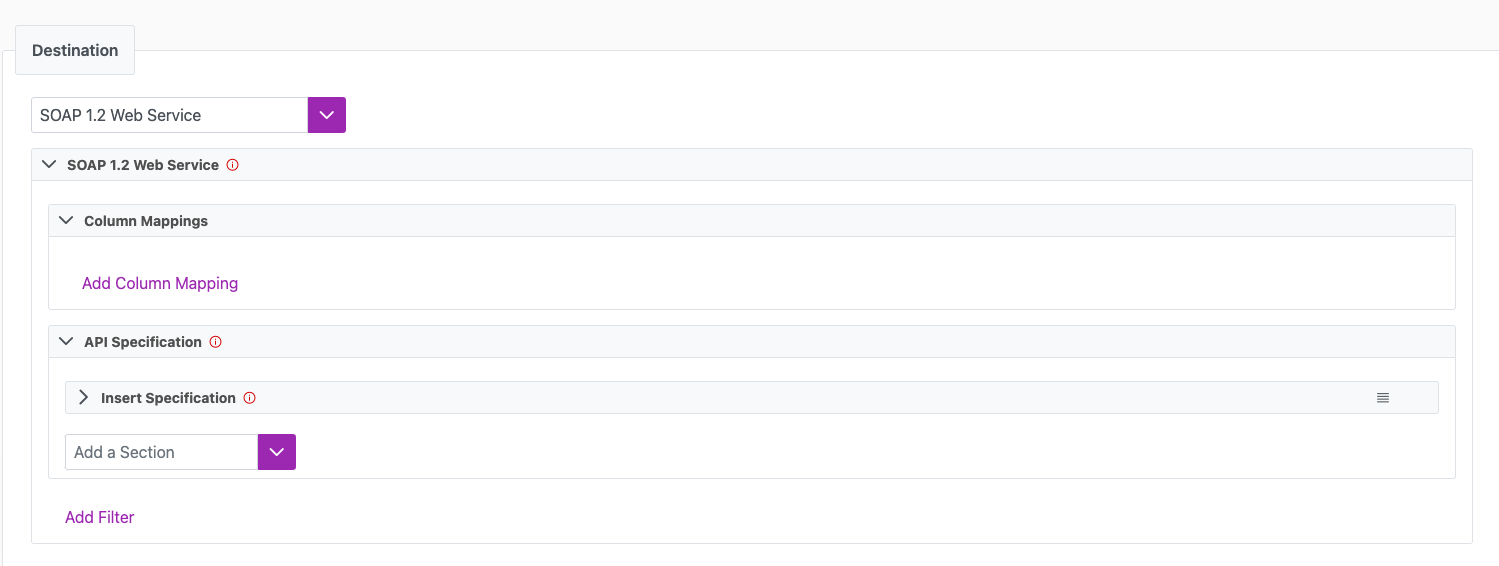SOAP 1.2 web service
Overview
SOAP (Simple Object Access Protocol) is an XML-based protocol for accessing web services over HTTP.
SOAP allows applications running on different operating systems to communicate using different technologies and programming languages. You can use SOAP APIs to create, retrieve, update or delete records, such as passwords, accounts, leads, and custom objects, from a server.
The SOAP 1.2 Web Service destination supports batch and real-time syncs.
Destination tab
The following table outlines the mandatory and optional parameters you will find on the Destination tab (Image 1).
- Destination details
- Column Mapping
- API Specification
- Filter
The following parameters will help to define your data sync destination and how it functions.
| Parameter | Description | Example |
|---|---|---|
| Destination | Mandatory. Select your destination from the drop-down menu. | SOAP 1.2 Web Service |
The Column Mapping section is where you define which source columns you want to sync to which destination columns. You can repeat the values for multiple columns.
When specifying the Target Column in the Column Mappings section, all names are case-sensitive.
| Parameter | Description | Example |
|---|---|---|
| Source Column | Mandatory. The name of your column as it appears in the source. | Name |
| Target Column | Mandatory. The name of your column as it appears in the destination. | Name |
The API Specification section will default with a mandatory Insert Specification field, however you are also able to add fields for Request Headers, SOAP Body, and Variables to Extract.
When specifying the Target Column in the Column Mappings section, all names are case-sensitive.
Insert Specification
| Parameter | Description | Example |
|---|---|---|
| Endpoint URL | Mandatory. The URL of the SOAP 1.2 Web Service API endpoint. | Endpoint URL Example |
| Has MTOM Response | Required to be true if the SOAP API response has an attachment outside the SOAP response message. See diagram for more info. | |
| Envelope Namespace | The namespace prefix for SOAP request elements. Defaults to 'soapenv', aligned with this schema: SOAP Envelope Schema. You can append the default. For example, using 'foo' prefixes the request with the 'foo' namespace. | Envelope Namespace Example |
| Namespace - Name | The namespace for your SOAP tags in both your request and response is specified in the 'Envelope Namespace' parameter. By default, the Connections UI will populate this field with soapenv, but you can delete this value or add additional values, as needed. | This value appears as "soap" in the snippet. These should be the values immediately after "xmlns:" |
| Namespace - Value | The URL describing this namespace in the response. By default, the Connections UI will populate this field with <http://schemas.xmlsoap.org/soap/envelope/>, however you can delete this value or add additional values, as needed. | In the snippet, this value is <http://www.dataaccess.com/webservicesserver/>. |
Request Header
You can add in Request Headers by reviewing the documentation here.
SOAP Body
| Parameter | Description | Example |
|---|---|---|
| XML | The SOAP body is part of the SOAP envelope and contains data for the recipient. | Example here |
Variables to Extract
You may choose to specify variables to extract from your SOAP response.
| Parameter | Description | Example |
|---|---|---|
| Name | The name of the variable you wish to extract. | Value |
| Path in Response | The path to the above variable. | soapenv:Envelope/soapenv:Body/m:NumberToWordsResponse/m:NumberToWordsResult[1] |
SOAP 1.2 Source
This section should be used if you have a set of data from a SOAP API that you need to reconcile against; therefore it should always be used when doing Full-File syncs. You can follow the values outlined on this page to set up this section.
You have the option to add a destination filter to your data sync. Please review the documentation here for more information on destination filters.

Next steps
- Define yourSync Actions. Note that if you are doing a Full-File sync, the API Specification > SOAP 1.2 Source section should be filled in.
- Add in your Post Sync Scripts, if required.
- Define your Permissions.
- If you are running a real-time sync, set up your Listener Config and enable it to begin your sync.
- If you are running a batch sync, click Jobs > Start a Job to begin your sync.
Appendix A
SOAP Parameter Examples
Envelope Namespace
<foo:Envelope xmlns:foo="...">
<foo:Body>
[Request XML]
</foo:Body>
</foo:Envelope
Namespace - Name
soapenv:Envelope
xmlns:<\a data-footnote-ref href="#user-content-fn-1">soap</\a>="http://schemas.xmlsoap.org/soap/envelope/">
soap:Body>
m:NumberToWordsResponse
xmlns:m="http://www.dataaccess.com/webservicesserver/">
m:NumberToWordsResult>four million four hundred and seventy three thousand two hundred and thirty nine /m:NumberToWordsResult>
/m:NumberToWordsResponse>
/soap:Body>
/soap:Envelope>
Namespace - Value
<?xml version="1.0" encoding="utf-8"?>
<soapenv:Envelope
xmlns:soap="http://schemas.xmlsoap.org/soap/envelope/">
<soap:Body>
<m:NumberToWordsResponse
xmlns:m="http://www.dataaccess.com/webservicesserver/">
<m:NumberToWordsResult>four million four hundred and seventy three thousand two hundred and thirty nine </m:NumberToWordsResult>
</m:NumberToWordsResponse>
</soap:Body>
</soapenv:Envelope>
SOAP Body
<NumberToWords xmlns="http://www.dataaccess.com/webservicesserver/">
<ubiNum>500</ubiNum>
</NumberToWords>